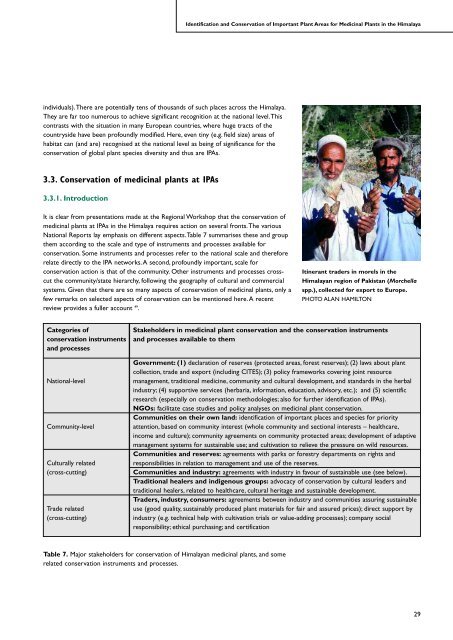Identification and Conservation of Important Plant Areas - Plantlife
Identification and Conservation of Important Plant Areas - Plantlife
Identification and Conservation of Important Plant Areas - Plantlife
- No tags were found...
Create successful ePaper yourself
Turn your PDF publications into a flip-book with our unique Google optimized e-Paper software.
<strong>Identification</strong> <strong>and</strong> <strong>Conservation</strong> <strong>of</strong> <strong>Important</strong> <strong>Plant</strong> <strong>Areas</strong> for Medicinal <strong>Plant</strong>s in the Himalayaindividuals).There are potentially tens <strong>of</strong> thous<strong>and</strong>s <strong>of</strong> such places across the Himalaya.They are far too numerous to achieve significant recognition at the national level.Thiscontrasts with the situation in many European countries, where huge tracts <strong>of</strong> thecountryside have been pr<strong>of</strong>oundly modified. Here, even tiny (e.g. field size) areas <strong>of</strong>habitat can (<strong>and</strong> are) recognised at the national level as being <strong>of</strong> significance for theconservation <strong>of</strong> global plant species diversity <strong>and</strong> thus are IPAs.3.3. <strong>Conservation</strong> <strong>of</strong> medicinal plants at IPAs3.3.1. IntroductionIt is clear from presentations made at the Regional Workshop that the conservation <strong>of</strong>medicinal plants at IPAs in the Himalaya requires action on several fronts.The variousNational Reports lay emphasis on different aspects.Table 7 summarises these <strong>and</strong> groupthem according to the scale <strong>and</strong> type <strong>of</strong> instruments <strong>and</strong> processes available forconservation. Some instruments <strong>and</strong> processes refer to the national scale <strong>and</strong> thereforerelate directly to the IPA networks.A second, pr<strong>of</strong>oundly important, scale forconservation action is that <strong>of</strong> the community. Other instruments <strong>and</strong> processes crosscutthe community/state hierarchy, following the geography <strong>of</strong> cultural <strong>and</strong> commercialsystems. Given that there are so many aspects <strong>of</strong> conservation <strong>of</strong> medicinal plants, only afew remarks on selected aspects <strong>of</strong> conservation can be mentioned here.A recentreview provides a fuller account 49 .Itinerant traders in morels in theHimalayan region <strong>of</strong> Pakistan (Morchellaspp.), collected for export to Europe.PHOTO ALAN HAMILTONCategories <strong>of</strong>conservation instruments<strong>and</strong> processesNational-levelCommunity-levelCulturally related(cross-cutting)Trade related(cross-cutting)Stakeholders in medicinal plant conservation <strong>and</strong> the conservation instruments<strong>and</strong> processes available to themGovernment: (1) declaration <strong>of</strong> reserves (protected areas, forest reserves); (2) laws about plantcollection, trade <strong>and</strong> export (including CITES); (3) policy frameworks covering joint resourcemanagement, traditional medicine, community <strong>and</strong> cultural development, <strong>and</strong> st<strong>and</strong>ards in the herbalindustry; (4) supportive services (herbaria, information, education, advisory, etc.); <strong>and</strong> (5) scientificresearch (especially on conservation methodologies; also for further identification <strong>of</strong> IPAs).NGOs: facilitate case studies <strong>and</strong> policy analyses on medicinal plant conservation.Communities on their own l<strong>and</strong>: identification <strong>of</strong> important places <strong>and</strong> species for priorityattention, based on community interest (whole community <strong>and</strong> sectional interests – healthcare,income <strong>and</strong> culture); community agreements on community protected areas; development <strong>of</strong> adaptivemanagement systems for sustainable use; <strong>and</strong> cultivation to relieve the pressure on wild resources.Communities <strong>and</strong> reserves: agreements with parks or forestry departments on rights <strong>and</strong>responsibilities in relation to management <strong>and</strong> use <strong>of</strong> the reserves.Communities <strong>and</strong> industry: agreements with industry in favour <strong>of</strong> sustainable use (see below).Traditional healers <strong>and</strong> indigenous groups: advocacy <strong>of</strong> conservation by cultural leaders <strong>and</strong>traditional healers, related to healthcare, cultural heritage <strong>and</strong> sustainable development.Traders, industry, consumers: agreements between industry <strong>and</strong> communities assuring sustainableuse (good quality, sustainably produced plant materials for fair <strong>and</strong> assured prices); direct support byindustry (e.g. technical help with cultivation trials or value-adding processes); company socialresponsibility; ethical purchasing; <strong>and</strong> certificationTable 7. Major stakeholders for conservation <strong>of</strong> Himalayan medicinal plants, <strong>and</strong> somerelated conservation instruments <strong>and</strong> processes.29
















